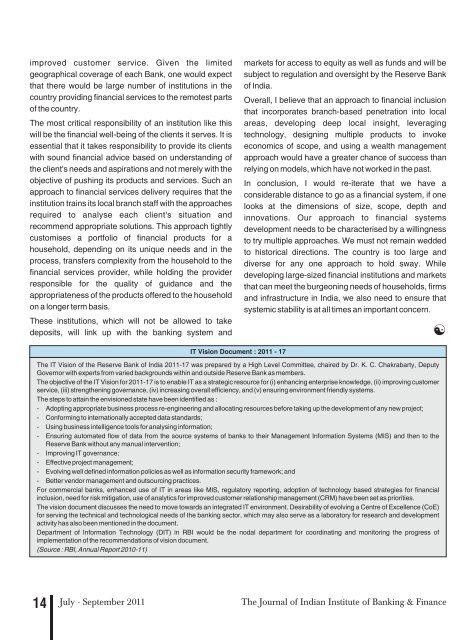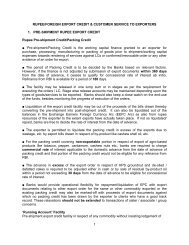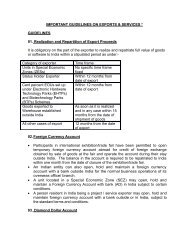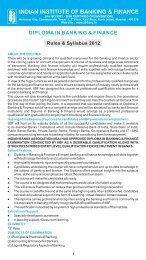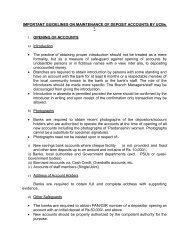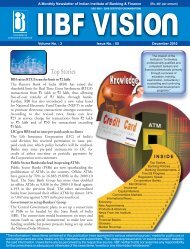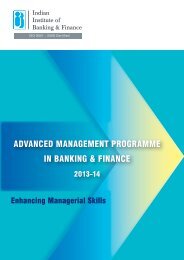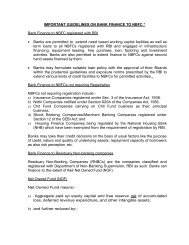Keb[ / DebkeÀ / pegueeF& - efmelebyej /
special feature - Indian Institute of Banking & Finance
special feature - Indian Institute of Banking & Finance
- No tags were found...
You also want an ePaper? Increase the reach of your titles
YUMPU automatically turns print PDFs into web optimized ePapers that Google loves.
special featureimproved customer service. Given the limitedgeographical coverage of each Bank, one would expectthat there would be large number of institutions in thecountry providing financial services to the remotest partsof the country.The most critical responsibility of an institution like thiswill be the financial well-being of the clients it serves. It isessential that it takes responsibility to provide its clientswith sound financial advice based on understanding ofthe client's needs and aspirations and not merely with theobjective of pushing its products and services. Such anapproach to financial services delivery requires that theinstitution trains its local branch staff with the approachesrequired to analyse each client's situation andrecommend appropriate solutions. This approach tightlycustomises a portfolio of financial products for ahousehold, depending on its unique needs and in theprocess, transfers complexity from the household to thefinancial services provider, while holding the providerresponsible for the quality of guidance and theappropriateness of the products offered to the householdon a longer term basis.These institutions, which will not be allowed to takedeposits, will link up with the banking system andmarkets for access to equity as well as funds and will besubject to regulation and oversight by the Reserve Bankof India.Overall, I believe that an approach to financial inclusionthat incorporates branch-based penetration into localareas, developing deep local insight, leveragingtechnology, designing multiple products to invokeeconomics of scope, and using a wealth managementapproach would have a greater chance of success thanrelying on models, which have not worked in the past.In conclusion, I would re-iterate that we have aconsiderable distance to go as a financial system, if onelooks at the dimensions of size, scope, depth andinnovations. Our approach to financial systemsdevelopment needs to be characterised by a willingnessto try multiple approaches. We must not remain weddedto historical directions. The country is too large anddiverse for any one approach to hold sway. Whiledeveloping large-sized financial institutions and marketsthat can meet the burgeoning needs of households, firmsand infrastructure in India, we also need to ensure thatsystemic stability is at all times an important concern.IT Vision Document : 2011 - 17The IT Vision of the Reserve Bank of India 2011-17 was prepared by a High Level Committee, chaired by Dr. K. C. Chakrabarty, DeputyGovernor with experts from varied backgrounds within and outside Reserve Bank as members.The objective of the IT Vision for 2011-17 is to enable IT as a strategic resource for (i) enhancing enterprise knowledge, (ii) improving customerservice, (iii) strengthening governance, (iv) increasing overall efficiency, and (v) ensuring environment friendly systems.The steps to attain the envisioned state have been identified as :- Adopting appropriate business process re-engineering and allocating resources before taking up the development of any new project;- Conforming to internationally accepted data standards;- Using business intelligence tools for analysing information;- Ensuring automated flow of data from the source systems of banks to their Management Information Systems (MIS) and then to theReserve Bank without any manual intervention;- Improving IT governance;- Effective project management;- Evolving well defined information policies as well as information security framework; and- Better vendor management and outsourcing practices.For commercial banks, enhanced use of IT in areas like MlS, regulatory reporting, adoption of technology based strategies for financialinclusion, need for risk mitigation, use of analytics for improved customer relationship management (CRM) have been set as priorities.The vision document discusses the need to move towards an integrated IT environment. Desirability of evolving a Centre of Excellence (CoE)for serving the technical and technological needs of the banking sector, which may also serve as a laboratory for research and developmentactivity has also been mentioned in the document.Department of Information Technology (DIT) in RBI would be the nodal department for coordinating and monitoring the progress ofimplementation of the recommendations of vision document.(Source : RBI, Annual Report 2010-11)14July - September 2011The Journal of Indian Institute of Banking & Finance


